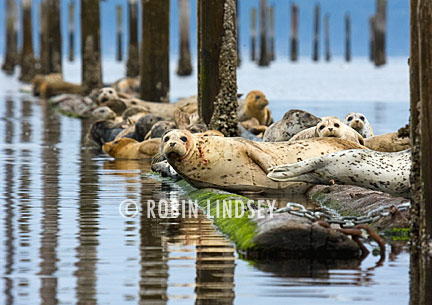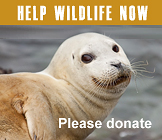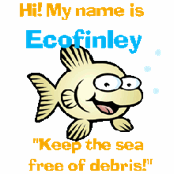Seal pups in a daily struggle to survive - please give them space
Jul/26/13 08:20 AM
UPDATE 7/26 3:45pm
The Olympia pup, positively identified, is not in danger, but instead is a healthy-looking weaned pup exhibiting normal behavior. The report of a “starving...abandoned” pup caused a media flurry and demands of rescue from the public, but the pup in question was observed today sneaking a bit of milk from a female nursing her own offspring. Often, a pup will call out with a plaintive “maaaaaaaa” even after weaning, seeking an easier meal from a female’s nipple than searching for tiny fish in the waters of Puget Sound. This pup should and will stay in the wild - like all pups whenever possible. (note: Adding to confusion, video footage widely shown by one Seattle tv station is of a nursing age pup - not the one originally reported to authorities and photographed by The Olympian)
In the first year of life, a harbor seal pup is in a constant struggle to survive. With a 50% mortality rate in the wild, they must overcome many challenges: disease, infection, predation by shoreline predators or domestic dogs, conditions caused by premature birth, dehydration and starvation. This is, unfortunately, a fact of life - and death.
 The current media coverage and resultant firestorm to rescue a “starving” seal pup in the Olympia area has overlooked some very important points. First of all, the pup is in a protected harbor seal haul-out and rookery. Each year, seals use a log boom in this bay to give birth and nurse their young (photo at left). Yesterday’s seal count at this thriving rookery, including logs just to the south, was 245 seals, of which 75 were pups. And each year at this rookery, between 5 and 20 pups die during pupping season, late June through September. In a nearby rookery, 30-60 pups die. The mortality rate at this rookery may be lower because it is indeed situated on the log boom, and much easier for seals to escape disturbance from eagles and coyotes (and boaters) because they are able to slip off into the water for protection. A number of pups may die and disappear into the water so are unaccounted for. This is the harsh reality of life for wild animals. Not every one survives nor should every one be rescued.
The current media coverage and resultant firestorm to rescue a “starving” seal pup in the Olympia area has overlooked some very important points. First of all, the pup is in a protected harbor seal haul-out and rookery. Each year, seals use a log boom in this bay to give birth and nurse their young (photo at left). Yesterday’s seal count at this thriving rookery, including logs just to the south, was 245 seals, of which 75 were pups. And each year at this rookery, between 5 and 20 pups die during pupping season, late June through September. In a nearby rookery, 30-60 pups die. The mortality rate at this rookery may be lower because it is indeed situated on the log boom, and much easier for seals to escape disturbance from eagles and coyotes (and boaters) because they are able to slip off into the water for protection. A number of pups may die and disappear into the water so are unaccounted for. This is the harsh reality of life for wild animals. Not every one survives nor should every one be rescued.
There has been a public outcry that the “abandoned” pup must be taken for rehabilitation. However, this pup is known to have come and gone from the logs into the water multiple times. There are many, many seals nearby. It has been documented in this and other rookeries that females will sometimes adopt an abandoned pup, nursing two at once (they only give birth to one pup). The body weight of this pup suggests that he or she might be sneaking milk from another mom - a female will sometimes relent to a persistent “sneaker”. And the possibility is not entirely ruled out that the pup is being nursed at night.
Rehabilitation is not the answer for all seal pups. First of all, many of them will not survive the stress of being captured and transported by car or truck to an authorized facility hours away. We must weigh many issues before making a decision to remove a pup from the wild. Even if they are rehabilitated and released months later with a dense layer of blubber, that does not ensure they will thrive in the wild. They still have only a 50% chance of survival their first year. A pup that has not been taught to hunt by mom has much less chance to forage successfully. A study by Sea Doc Society revealed that rehabbed pups travel much farther in search of food than wild-weaned pups, wasting precious calories. A human tossing fish into a small pool does not replicate catching fast-swimming fish in expansive waters. Rehabilitation does not guarantee an animal’s survival post release. Additionally, Washington has no major marine mammal rehab facilities. There is extremely limited space for lengthy pup rehabilitation, so each decision to remove an animal from the wild is on a case by case basis taking into account numerous factors. Read NOAA’s policy on harbor seal pup rehabilitation here.
The question has been asked, “What is the harm in helping him?” In reality, there is much harm that can be done. We cannot jeopardize the health of the many pups at this or any rookery in hopes of saving one. This time of year in Puget Sound, pups are being born every single day. If humans intervene and disrupt the normal activity in these areas, other pups may well be abandoned and starve to death. Human disturbance has serious consequences.
Seal Sitters supports the decision not to intervene in this case - and there is the fervent hope that this pup will make it. Sadly, we can’t save all seal pups. And many would argue, it is not our place in nature to do so. It is heartbreaking for any member of the Marine Mammal Stranding Network to have to observe a struggling pup and respect nature’s role. We are passionate about keeping seal populations healthy and thriving - and do everything we can to give pups the space to get stress-free rest, away from human interference. Not every seal pup will survive this pupping season and we all share sadness in that hard fact - but know that there is a reason for this very fragile balance of nature.
Do not take matters into your own hands if you come across a pup - they are protected by Federal law. It is illegal to feed, touch or move a pup. If you break the law and take a pup to a wildlife facility, they cannot legally treat the animal. NOAA’s Office for Law Enforcement will investigate all instances of human interference. Call NOAA’s stranding hotline at 800-853-1964 to report a pup you are concerned about.
Please read NOAA’s most recent Q&A publication “Share the Shore with Harbor Seal Pups” here. The document describes the life processes of harbor seals, what to do if you come across a pup and NOAA’s policy on rehabilitation. Please do “Share the Shore” and observe these magnificent animals quietly from a distance.
Please note: The Olympian newspaper which originally broke the story of a “starving” pup has now updated their website with the news that the pup is indeed a healthy, weaner.
The Olympia pup, positively identified, is not in danger, but instead is a healthy-looking weaned pup exhibiting normal behavior. The report of a “starving...abandoned” pup caused a media flurry and demands of rescue from the public, but the pup in question was observed today sneaking a bit of milk from a female nursing her own offspring. Often, a pup will call out with a plaintive “maaaaaaaa” even after weaning, seeking an easier meal from a female’s nipple than searching for tiny fish in the waters of Puget Sound. This pup should and will stay in the wild - like all pups whenever possible. (note: Adding to confusion, video footage widely shown by one Seattle tv station is of a nursing age pup - not the one originally reported to authorities and photographed by The Olympian)
In the first year of life, a harbor seal pup is in a constant struggle to survive. With a 50% mortality rate in the wild, they must overcome many challenges: disease, infection, predation by shoreline predators or domestic dogs, conditions caused by premature birth, dehydration and starvation. This is, unfortunately, a fact of life - and death.

There has been a public outcry that the “abandoned” pup must be taken for rehabilitation. However, this pup is known to have come and gone from the logs into the water multiple times. There are many, many seals nearby. It has been documented in this and other rookeries that females will sometimes adopt an abandoned pup, nursing two at once (they only give birth to one pup). The body weight of this pup suggests that he or she might be sneaking milk from another mom - a female will sometimes relent to a persistent “sneaker”. And the possibility is not entirely ruled out that the pup is being nursed at night.
Rehabilitation is not the answer for all seal pups. First of all, many of them will not survive the stress of being captured and transported by car or truck to an authorized facility hours away. We must weigh many issues before making a decision to remove a pup from the wild. Even if they are rehabilitated and released months later with a dense layer of blubber, that does not ensure they will thrive in the wild. They still have only a 50% chance of survival their first year. A pup that has not been taught to hunt by mom has much less chance to forage successfully. A study by Sea Doc Society revealed that rehabbed pups travel much farther in search of food than wild-weaned pups, wasting precious calories. A human tossing fish into a small pool does not replicate catching fast-swimming fish in expansive waters. Rehabilitation does not guarantee an animal’s survival post release. Additionally, Washington has no major marine mammal rehab facilities. There is extremely limited space for lengthy pup rehabilitation, so each decision to remove an animal from the wild is on a case by case basis taking into account numerous factors. Read NOAA’s policy on harbor seal pup rehabilitation here.
The question has been asked, “What is the harm in helping him?” In reality, there is much harm that can be done. We cannot jeopardize the health of the many pups at this or any rookery in hopes of saving one. This time of year in Puget Sound, pups are being born every single day. If humans intervene and disrupt the normal activity in these areas, other pups may well be abandoned and starve to death. Human disturbance has serious consequences.
Seal Sitters supports the decision not to intervene in this case - and there is the fervent hope that this pup will make it. Sadly, we can’t save all seal pups. And many would argue, it is not our place in nature to do so. It is heartbreaking for any member of the Marine Mammal Stranding Network to have to observe a struggling pup and respect nature’s role. We are passionate about keeping seal populations healthy and thriving - and do everything we can to give pups the space to get stress-free rest, away from human interference. Not every seal pup will survive this pupping season and we all share sadness in that hard fact - but know that there is a reason for this very fragile balance of nature.
Do not take matters into your own hands if you come across a pup - they are protected by Federal law. It is illegal to feed, touch or move a pup. If you break the law and take a pup to a wildlife facility, they cannot legally treat the animal. NOAA’s Office for Law Enforcement will investigate all instances of human interference. Call NOAA’s stranding hotline at 800-853-1964 to report a pup you are concerned about.
Please read NOAA’s most recent Q&A publication “Share the Shore with Harbor Seal Pups” here. The document describes the life processes of harbor seals, what to do if you come across a pup and NOAA’s policy on rehabilitation. Please do “Share the Shore” and observe these magnificent animals quietly from a distance.
Please note: The Olympian newspaper which originally broke the story of a “starving” pup has now updated their website with the news that the pup is indeed a healthy, weaner.







